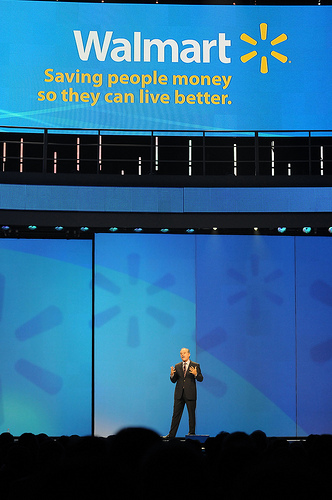 I’m not a gambling man but I’m prepared to bet that many people who read of China’s approval of Wal-Mart’s acquisition of 51% of Yihaodian this week probably said “who?”. They would most likely be readers from outside China who have never heard of this super-star of e-commerce.
I’m not a gambling man but I’m prepared to bet that many people who read of China’s approval of Wal-Mart’s acquisition of 51% of Yihaodian this week probably said “who?”. They would most likely be readers from outside China who have never heard of this super-star of e-commerce.
Yihaodian is only four years old and in the last three years it has grown by over 19000% and employs 4200. It sells over 180,000 products which can be delivered within 24hours to the residents of 30 of the largest cities in China (which represent some of the world’s largest cities).
But above all its cool – it has marked its territory with an outstanding Ad Campaign, created by Ogilvy and Mather Shanghai which encourages shoppers to ditch traditional retail in favor of the ease of shopping at home. (1)
For China’s young, educated professional class Yihaodian is the only way to go. Irene Luo, a member of our team at sums this up, “Now I buy 90% of my groceries from this e-retailer except fresh food (but they do sell fresh food as well).” She goes on to say “You just need to buy over RMB 100 stuff, then you can get free delivery next day. So you can see how popular Yihaodian is here [Shanghai]”
Wal-Mart’s purchase of conditional control of this player is therefore big news in China. It should be big news worldwide and here’s why:
1) e-commerce is a global story
For most of the last decade most of the big news in eTail has come out of the US and South Korea where great logistics have been matched with great Internet infrastructure. Yihaodian’s success shows the potential for e-commerce in not just in the mega-cities of China but across the emerging economies of Asia and beyond. China’s e-commerce market is set to be the world’s largest by 2015, according to Boston Consulting Group and this demonstrates that the new generation of shoppers markets can easily be served, even in environments where logistics and broadband infrastructure remain a challenge. The days when nay-sayers claim ‘it could never happen here’ are numbered.
2) Global retailers now see e-commerce as the next channel for expansion
Major grocery multinationals have, for at least the last decade, sought new channels to expand into. Many have realized that the time of the hypermarket format is over and many have sought new growth in convenience retail and speciality stores. Some, such as Tesco in Korea and the UK, have made successful forays online already. But what’s happening in China is new, in that it indicates the potential for offline retail consolidation (2) to go online. Such expansion is, in effect borderless, which may lead to retail brands, whose global expansion has been stymied by geographical barriers to entry, launching into markets without the need to gain critical store mass.
3) If you can’t beat them, buy ‘em
Let’s be really clear, Yihaodian has been winning battles in China with younger shoppers. Its cooler, easier, better stocked, more reliable and altogether more attuned to this generations shoppers than the big boxes like Carrefour (3). In other sectors 360buy.com has been kicking bricks and mortar’s ass over the last two years (4) and the potential for grocery to go this same way has clearly been recognised by Wal-Mart. The great lesson here is that with mammoth cash piles the potential to buy upstarts to mitigate the downsides of e-commerce cannibalising existing store sales is absolutely here.
4) Manufacturers, globally, have got to take note
Consolidated retail is a problem for manufacturers now, it will be a greater problem for them in cyberspace. Greater choice will put pressure on brands; global price comparison and competition will force prices down; whilst marketing complexity will increase. Today’s consumer goods companies still rely on marketing models created in the 1950’s for the run of the strategic thinking and these models were never meant to cope the realities of media fragmentation and retail consolidation of the 90’s – let alone the challenges that e-commerce poses. Addressing both the opportunities and the issues will require some major re-calibration of the way people think about marketing and selling consumer goods and time is running out.
Ok so I’ve said this before (5) BUT this not just about the boardroom setting up a task force in key markets, it’s really about operational units addressing the e-commerce potential directly too. How many sales directors have this on their agenda now? In many markets, these guys have not yet got beyond ‘modern trade’ and ‘general trade’. That thinking may cost company’s big time, especially in markets which have avoided the onslaught of global players to date.
Wal-Mart’s move this week is probably not high on the agenda in many HQ’s this week but it is a major shift – it is likely to be the beginning of a new wave.
____________________________________________________________________
Feature image from Flickr – Walmart Corporate
(1) Yihaodian launches its latest “The Best Choice” campaign to spark a conversation about grocery shopping – I like the Donkey!
(2) How Retail Consolidation Wrecks Consumer Goods Markets
(3) Why Carrefour Could Fail In China
(4) Does China’s E-commerce rise signal the future of bricks and mortar globally?